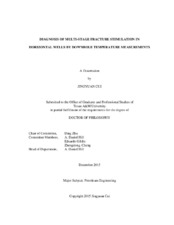| dc.contributor.advisor | Zhu, Ding | |
| dc.creator | Cui, Jingyuan | |
| dc.date.accessioned | 2016-05-04T13:21:27Z | |
| dc.date.available | 2016-05-04T13:21:27Z | |
| dc.date.created | 2015-12 | |
| dc.date.issued | 2015-11-19 | |
| dc.date.submitted | December 2015 | |
| dc.identifier.uri | https://hdl.handle.net/1969.1/156450 | |
| dc.description.abstract | Fractured well performance diagnosis for a multiple-stage fractured horizontal well is critical to understand and improve fracture stimulation design. Temperature distribution data (by production logging tools or fiber-optic sensors) is one of the valuable information for performance diagnosis. However, until today quantitative interpretation of dynamic temperature data is still challenging and requires in-depth mathematical modeling of heat and mass transfer during production in a complex flow system.
The interpretation models developed to translate temperature data to flow conditions can be fully numerical-based simulations or analytical/semi-analytical approaches. With reasonable assumptions analytical/semi-analytical models are more suitable for real-time field applications. This dissertation presents the applications of using a coupled semi-analytical fracture model and a wellbore model to predict the temperature and pressure behavior in multiple-fractured horizontal wells in unconventional reservoirs during production. The thermal model calculated heat transfer in the fracture/reservoir/wellbore system considering subtle temperature changes caused by the Joule-Thomson cooling effect. The results showed that the wellbore fluid temperature behavior is sensitive to the flow condition, and can be used to estimate fracture initiation points, number of created fractures and flow profile along the horizontal wellbore.
This dissertation discusses the characteristics of transient temperature behaviors corresponding to different wellbore constraints, and also the fracture volume which influence the flow rate/temperature distribution along a fractured horizontal wellbore. The temperature drop when gas entering the wellbore is more obvious at the toe and is weaken towards the heel with the uniform inflow rate distribution due to the fluid mixing inside the wellbore. Field cases are presented to illustrate the application of using the temperature model to understand the fracture/flow distribution. The estimation of flow rate distribution from the temperature model is compared to the interpretation of flow by production logging tools (PLT) and commercial software. The flow profile from the temperature model presents consistent trend with PLT measurement. It is more sensitive to the fluid entries (fracture locations) and less sensitive to the influence of flow regime inside the wellbore when compared with the interpretation from array production logging tools.
The fast marching method (FMM) is presented in this study to get the thermal map near hydraulic/natural fractures. This method solves the front tracking problems efficiently. By doing so, we can consider a heterogeneity formation with fractures, and also complex fracture geometry compared with analytical solution. It is also superior in visibility of stimulated reservoir volume (SRV) and in computational efficiency compared to finite difference simulation. | en |
| dc.format.mimetype | application/pdf | |
| dc.language.iso | en | |
| dc.subject | fracture diagnosis | en |
| dc.subject | downhole temperature interpretation | en |
| dc.title | Diagnosis of Multi-Stage Fracture Stimulation in Horizontal Wells by Downhole Temperature Measurements | en |
| dc.type | Thesis | en |
| thesis.degree.department | Petroleum Engineering | en |
| thesis.degree.discipline | Petroleum Engineering | en |
| thesis.degree.grantor | Texas A & M University | en |
| thesis.degree.name | Doctor of Philosophy | en |
| thesis.degree.level | Doctoral | en |
| dc.contributor.committeeMember | Hill, Dan | |
| dc.contributor.committeeMember | Gildin, Eduardo | |
| dc.contributor.committeeMember | Cheng, Zhengdong | |
| dc.type.material | text | en |
| dc.date.updated | 2016-05-04T13:21:27Z | |
| local.etdauthor.orcid | 0000-0003-1317-2840 | |


